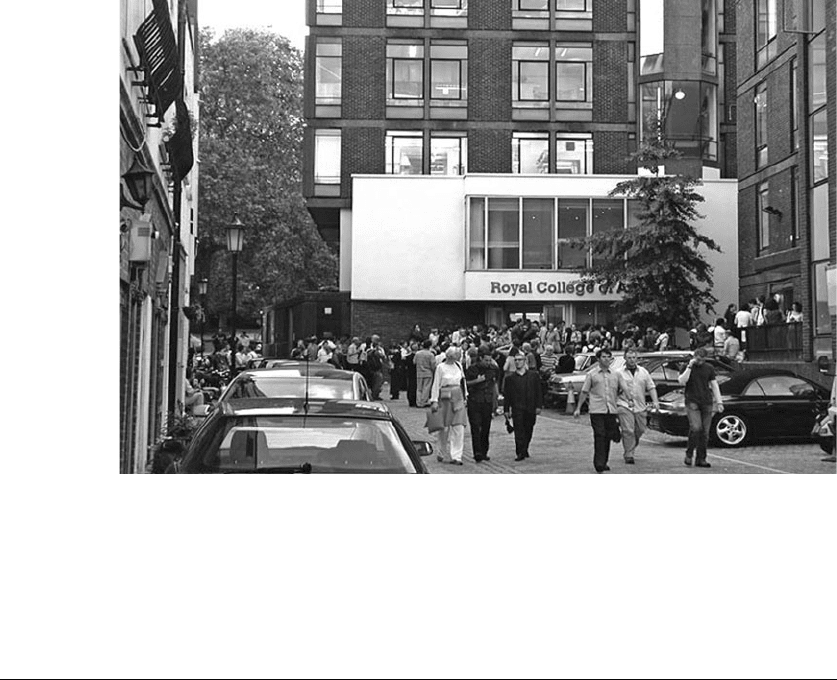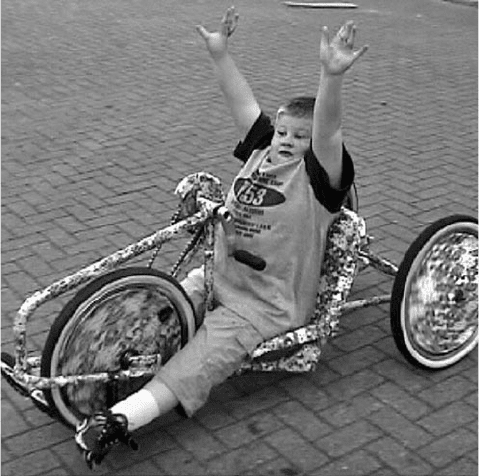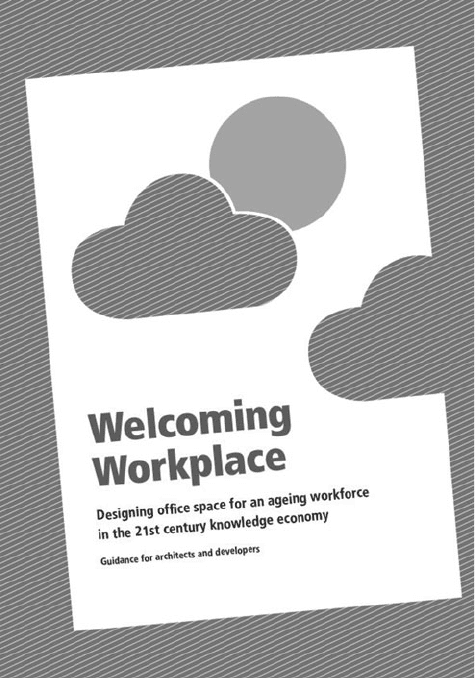Preiser W., Smith K.H. Universal Design Handbook
Подождите немного. Документ загружается.

This page intentionally left blank

EDUCATION AND RESEARCH
P
O
A
O
R
O
T
5
This page intentionally left blank

CHAPTER 36
INCLUSIVE DESIGN RESEARCH
INITIATIVES AT THE ROYAL
COLLEGE OF ART
Jeremy Myerson and Yanki Lee
36.1 INTRODUCTION
A distinctive theme of design research at the Royal College of Art, London, over the past 40 years
has been work that combines social activism with application by industry. From Kenneth Agnew and
Bruce Archer’s pioneering project to develop a new standard hospital bed for the National Health
Service in the late 1960s to the DesignAge program set up by Roger Coleman in 1991 to explore
design for aging populations (see Chap. 21), the Royal College of Art has maintained a practical
interest in people-centered design research that jointly benefits society and business.
It was within this culture of practice-based action research that Roger Coleman and Jeremy
Myerson established the Helen Hamlyn Centre in January 1999 as the successor to DesignAge,
positioning a new unit dedicated to research initiatives in inclusive design at the heart of the world’s
only postgraduate university wholly of art and design (see Fig. 36.1). From the start, the approach
of the RCA’s new center was to collaborate directly with businesses, charities, and public sector
bodies, uniting social need with commercial application through design, and involving the students
and graduates of the college’s studio-based design culture in the process.
This chapter explores the Helen Hamlyn Centre’s flagship research initiatives over a 10-year
period between 1999 and 2009. It describes how a series of interactions with three distinct design
communities—students, new graduates, and professional designers—helped to form a distinctive
program of inclusive design education and research which responded to the call in the Royal Charter
of the College (1967) to “advance learning, knowledge and professional competence’ in art and
design in relation to ‘social developments.”
Many key aspects of the Helen Hamlyn Centre extended the social agenda of DesignAge at
the Royal College of Art, in particular a focus on “design for our future selves,” which provided a
persuasive platform for students to engage in an awards scheme. Furthermore, there was a focus on
industry partnership, which gave new graduates an opportunity to test themselves in the field via
the Helen Hamlyn Research Associates program. Likewise, there was a focus on rapid, team-based
design challenges for professionals, which enabled hundreds of designers to address extreme user
needs via the Challenge Workshops.
36.3

36.4 EDUCATION AND RESEARCH
36.2 METHODOLOGY: DESIGNER AS RESEARCHER
A key to the DesignAge experience at the RCA (1991 to 1998) was that bringing design-excluded
communities, such as older adults and people with disabilities, from the margins to the mainstream
of society required a new generation of designers. Another important lesson was the outlook that
designers would bring—one of seeing the bigger picture of social change and designing for their
own futures, not restricting their view to the design of disability aids for the excluded. Thus, from
the outset, the Helen Hamlyn Centre (HHC) set its own overriding research question—how to equip
designers in all disciplines, from students to seasoned professionals, with the means to practice a
more inclusive form of mainstream design.
In their emphasis on user participation and social engagement, the Helen Hamlyn Centre’s activi-
ties can be seen as confronting core practices in art and design education, which has historically
trained design students and professional designers to think egocentrically and look within them-
selves for answers to design problems (Moggridge, 2001), each participant designing according to
his or her own aesthetic values and preferences. The role of users, however, is central within the
design process, carefully framed in terms of who is included and who is excluded (Myerson, 2001).
Mindful of its place as part of the RCA’s rich tradition of designer-led practice, the Centre has
initiated activities that are themselves designer-oriented in that research methods and tools can be
demonstrated as designers’ activities.
The designer is encouraged to perform as both researcher and creator within one seamless
process, observing human behavior and designing in response to it. It has been the HHC’s belief
FIGURE 36.1 The Jay Mews entrance of the Royal College of Art, Kensington Gore, London, United Kingdom.
Long description: This black-and-white photograph taken in summertime shows the Jay Mews entrance of the Royal
College of Art in Kensington Gore, London, seen from midway down the cobbled mews which leads up to it. In the
background is the modernist brick and concrete Darwin Building completed in 1959 and designed by then RCA staff
member H. T. Cadbury-Brown. The mews serves as the car park for the RCA and is packed with cars. Many people can
be seen leaving the RCA after a daytime event. Some are talking in groups while others are walking down the mews
toward the camera.

INCLUSIVE DESIGN RESEARCH INITIATIVES AT THE ROYAL COLLEGE OF ART 36.5
that the designer should be educated to act as an advocate on behalf of the user. In this case,
each participant is encouraged to listen carefully to her or his “voice,” never abdicating creative
responsibility and always retaining the capacity to act and innovate autonomously, balanced by
rigorous research.
36.3 ENGAGING STUDENTS
As part of the RCA, the HHC has access to a large pool of postgraduate design students across
various art and design disciplines. By introducing inclusive design practices to students, it was
anticipated that essential methodologies would diffuse outward into practice after graduation. Given
that published data about the employment patterns of RCA graduates indicate that 93 percent will
work at a high level in the professional fields for which they trained, engagement with the college’s
design students was given a high priority. But there was a further objective in working with students;
the intention was to identify and recruit designer-researchers to advance the HHC’s own research
agenda.
The HHC decided to adapt the DesignAge Competition (1992 to 1999), which gave RCA stu-
dents awards for designing for older people, by broadening it to address a wider range of social
groups and issues. A larger, more general design awards scheme was devised under the banner of
“Design for Our Future Selves,” encompassing how we might live, work, and travel in the future.
This broader framework enabled design for aging, changing patterns of work, new ideas for health
care, and emerging themes such as sustainable communities to be considered; and a range of com-
mercial and charitable sponsors signed up to offer prizes in different categories.
Between 2000 and 2008, around 800 students from art and design disciplines across the RCA
entered this revised awards program. More than 300 student projects were short-listed, and in excess
of £60,000 was awarded in prize money from sponsors. A key element was that each short-listed stu-
dent have a learning experience in inclusive design, with access to HHC researchers and user groups
to discuss, hone, and test ideas and prototypes. Critically, award winners, such as cycle designer
Ben Wilson with his Tilting Trike for children with minimal lower body strength (see Fig. 36.2) and
architectural designer Yanki Lee with her urban park for different generations to share, advertised
their capacity to join the HHC upon graduation as research associates.
36.4 INTERACTION WITH NEW GRADUATES
DesignAge had experimented with industry projects, but the Helen Hamlyn Research Associates
program, which took its first cohort of 10 RCA graduates in October 1999 and teamed them up with
a range of external organizations, was devised as a way to systematize such experiences for newly
minted designers at the college. The format was to employ the graduates within the HHC for one
calendar year and facilitate real-world projects with industry and the voluntary sector. Immediately,
the scheme hit a rich seam of collaboration, introducing graduates to inclusive design in a more
in-depth way than the student program had done. Over the next decade, more than 100 RCA
graduates would follow this route, working with nearly 70 industrial partners including Unilever,
GlaxoSmithKline, Orange, Ford, Toyota, IDEO, Nokia, Philips, Hewlett-Packard, B&Q, and the
British Heart Foundation.
A glance back at that first cohort of 1999 to 2000 reveals themes that have endured. For example,
there were projects that addressed the needs of people socially excluded due to age and disability as
well as those marginalized by economic and technological change. In that first year, the HHC began
a study of ways to improve personal navigation around Heathrow Airport for BAA (formerly the
British Airports Authority), a project that would eventually result in a set of guidelines for way-finding
in Heathrow Terminal 5, the Richard Rogers building which opened in 2008 as Europe’s largest
airport terminal.

36.6 EDUCATION AND RESEARCH
The program worked with the National Group on Homeworking, the Design Council, and
Leonard Cheshire Homes to devise practical tools and furniture to support low-paid and disabled
home workers, some of the poorest and most vulnerable groups in society. It also conducted research
for Dyson and Levi-Strauss to develop innovations that help older people to clean their homes more
easily and avoid injuries through falling. That first year set a pattern to which future cohorts of
Research Associates over the next 10 years would adhere. In a time of rapid demographic change,
the program deliberately focused the skills and knowledge of RCA’s studio departments on issues
related to social inclusion. Within the college, the Departments of Architecture, Communication
Art and Design, Design Interactions, Design Products, Industrial Design Engineering, and Vehicle
Design became regular design collaborators. Among the applied artists, for instance, ceramics and
glass designers joined the program to develop a new walk-in bath for older adults.
As the HHC emerged as the college’s center for inclusive design, its Research Associates broad-
ened both the subject matter and the research partnerships. An early emphasis on design for age and
disability broadened to embrace research projects dedicated to improving patient safety and develop-
ing innovative ideas for business as digital technology opened up new opportunities. No corner of the
FIGURE 36.2 The award-winning Tilting Trike by RCA design products
graduate Ben Wilson (2002). This new pedal-powered tricycle for children can
be adapted to the needs of those without lower body strength.
Long description: This photograph shows a young boy aged around 12 with
short hair seated on the prototype of the Tilting Trike designed for children
by RCA graduate Ben Wilson in 2002. It can be adapted to the needs of those
without lower body strength as is the case for the boy in the picture. His legs
are stretched out straight in front of him. and he is raising his arms in triumph
after a test run. This new-generation trike is modular in design, advanced in
bicycle technology and contemporary in style with a multicolored patterned
frame and wheel spokes. Importantly, it can be reconfigured swiftly from a foot
pedal–powered vehicle to one that is pedaled by hand because it is assembled
using existing readymade bicycle components in different configurations. The
version shown is the hand-pedaled one. It also has a unique steering mechanism
that enables the user to steer by redistributing his or her body weight.

INCLUSIVE DESIGN RESEARCH INITIATIVES AT THE ROYAL COLLEGE OF ART 36.7
design map was left untouched in the search for more inclusive solutions—from street lighting and
urban transport to office design, food packaging (see Fig. 36.3), and hospital patient safety.
Blanchard (2003) wrote of the program: “The Helen Hamlyn Centre is all about encouraging
young designers to think beyond yet another ergonomic shiny toaster, or the lemon juicer that looks
like a UFO. Rather than making things consumers want because they look pretty in a glossy maga-
zine, these designers make things we need, things that might improve our lives in some way.”
36.5 DISCOVER-DEFINE-DEVELOP-DELIVER
As an applied research program, the Helen Hamlyn Research Associates deliberately sits midway
between academia and business. Graduates unconstrained by M. Phil. or Ph.D. demands are paid
RCA staff researchers undertaking projects directly with industry. Companies pay to collaborate
with graduates at the HHC, which manages both selected design graduates and business partners in
order to cocreate inclusive design exemplars.
Each project is divided into four distinct phases in line with the three terms of the RCA academic
year and the summer break: the discover phase (autumn term), define (spring term), develop (summer
FIGURE 36.3 Easy-to-open food packaging, a design study by Helen Hamlyn Research
Associates, Richard Hartshorn and Edward Goodwin (2002), for the U.K. supermarket chain
Waitrose.
Long description: This photo is an aerial view of three aluminum drink cans showing their
ring-pull openers only. At the top and to the right are conventional versions. In the foreground
is the improved ring-pull designed with a significantly enlarged ring that is wide at the base and
tapers toward the tab that fastens it to the can and enables it to be pulled open easily. This project
set out to improve the openability of Waitrose’s own-brand ranges, starting with a detailed audit
of own-brand and proprietary food product packaging and extensive user research among older
consumers. Five of the most problematic pack types were redesigned: bacon packs, fresh soup
pots, ring-pull tins, jam jars, and sardine tins. Improvements were proposed that can be intro-
duced quickly at low cost with minimal disruption to machinery. Waitrose was given a “research
map” to address openability issues across its own-brand range in the future.

36.8 EDUCATION AND RESEARCH
term), and deliver (summer break). The discover phase follows an induction period with professional
skills training in such areas as project management, presentation, user research, writing, and film-
making. This is a period for exploration. Researchers investigate the context of the project and learn
to conduct market analysis, reviewing the literature and building a working relationship with the
research partner. The define phase is a time to focus—preliminary user studies help to define a point
of view and decide which areas or ideas to prioritize. Early design concepts are generated through
prototyping.
The third phase of the program, develop, consolidates design directions in partnership with the
research partner. Scenarios and prototypes are created. Relevant processes and technologies are
investigated. Ideas are validated with experts and in user trials. Modifications are made, and final
communication outputs are determined as the project enters the final straight. The deliver phase
completes the project by giving the partner the results and outcomes of the study in a form that is
of the most practical and applicable use to the organization—whether exemplar designs, prototypes,
films, guidelines, or publications. The final results of the Research Associates projects are publicly
disseminated via an annual show and symposium at the RCA each September, held as part of the
London Design Festival.
36.6 EXPANDING RESEARCH THEMES
Short applied projects of the kind practiced by the Helen Hamlyn Research Associates did more than
just enable the HHC to address its core research question of how to help designers work more inclu-
sively. They also acted as a forerunner to larger research programs funded by the major U.K. research
councils, by demonstrating expertise in particular areas. For example, the clustering of three years of
Research Associate studies related to giving older people better access to the workplace (supported
by industry partners DEGW Architects, Steelcase, Kinnarps, and others) resulted in a major award
to the HHC from Designing for the 21st Century, a joint initiative by two U.K. research councils for
a project entitled Welcoming Workplace (see Fig. 36.4).
Similarly, a cluster of projects for patient safety by Research Associates led directly to a two-
year multidisciplinary research project funded by the EPSRC (Engineering and Physical Sciences
Research Council) to redesign emergency mobile health care services (see Fig. 36.5). This radical
rethinking of the traditional ambulance teamed up the HHC and RCA Vehicle Design with four other
U.K. universities.
The HHC might have been expected to focus its research effort exclusively on the development
of inclusive design, following the introduction of the concept in the early 1990s (Coleman, 1994).
Indeed, in 2000, under Coleman’s direction the center became a key player with the Engineering
Design Centre at Cambridge University in a research consortium called i~design, dedicated to giving
tools and guidance to designers and business decision makers on the practice of inclusive design.
But as its research program expanded, the center diversified into two adjacent areas of people-centered
design: workplace design and design for patient safety. In autumn 2008, e.g., the HHC began a
new funded collaboration with clinicians and psychologists at Imperial College London entitled
DOME (Designing Out Medical Error). Former Research Associates were recruited into more senior
research roles to undertake the project.
36.7 WORKING WITH PROFESSIONALS
While RCA students and graduates were gaining inclusive design methodologies on HHC programs,
the wider design industry in the United Kingdom was also a target for inclusive design education. To
work with professional designers, the center adopted a different approach. It collaborated with the
Design Business Association (DBA), the major trade body for design firms in the United Kingdom,
to establish the DBA Inclusive Design Challenge.

INCLUSIVE DESIGN RESEARCH INITIATIVES AT THE ROYAL COLLEGE OF ART 36.9
Beginning in 2000, the challenge was set up as a five-month, designer-friendly mechanism to
transfer knowledge to design consulting firms and their industry clients about inclusive design
concepts and processes. The format was an immediate success with DBA member firms eager to
participate, expose their teams to working with disabled creative partners, and compete for an annual
award given by the RCA.
In January 2005, the design firm Sieberthead asked the HHC to devise a short, three-day
innovation workshop for staff of the multinational giant Reckitt Benkiser, based on the principles
FIGURE 36.4 Front cover of a design guidance document for architects and
developers from the Welcoming Workplace study (2006–2008), www.welcom-
ingworkplace.com.
Long description: This photo shows the cover of the report, entitled
“Welcoming Workplace—Designing Office Space for an Aging Workforce
in the 21st Century Knowledge Economy—Guidance for Architects and
Developers.” This research project was conducted between January 2007 and
December 2008 by the Royal College of Art Helen Hamlyn Centre and funded
as part of the Designing for the 21st Century initiative. The graphic elements
of the rectangular (A4) cover are the title, a light colored background with two
cutout clouds and a sun placed on a diagonally striped darker background.
